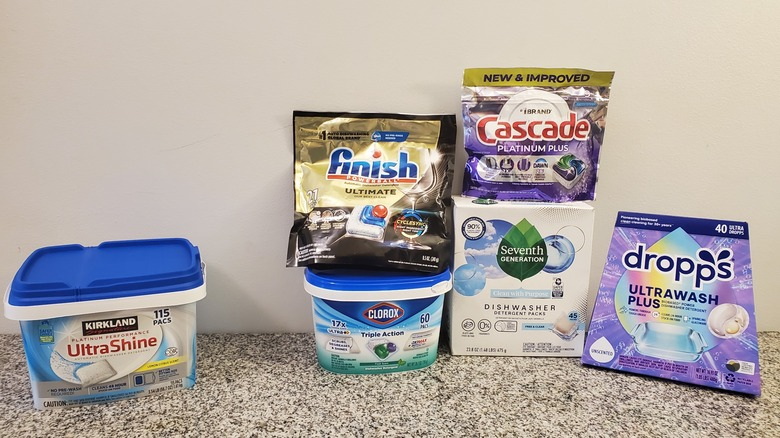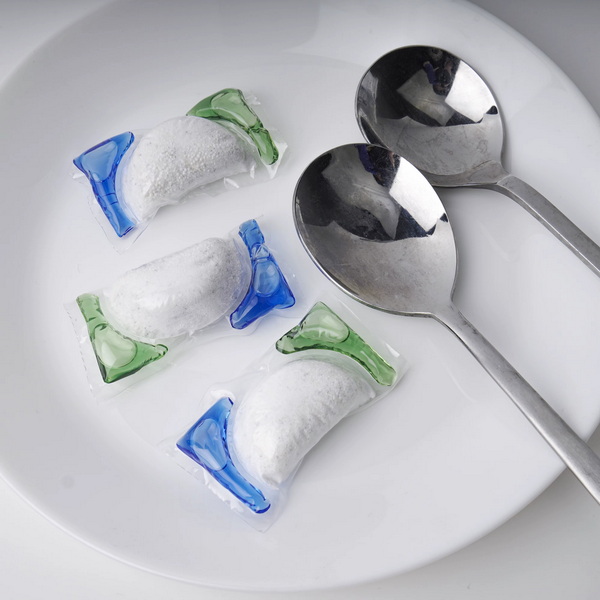Dongguan UFine Daily Chemical Co.,Ltd.
- All
- Product Name
- Product Keyword
- Product Model
- Product Summary
- Product Description
- Multi Field Search
Views: 222 Author: Tomorrow Publish Time: 10-18-2025 Origin: Site











Content Menu
● The Early History of Dishwasher Detergents
● The Introduction of Dishwasher Pods
● Advantages That Boosted Popularity
● Key Players in the Dishwasher Pod Market
● Technological Innovations in Dishwasher Pods
● The Market Expansion and Consumer Adoption
● Environmental and Safety Concerns
● Current Trends and the Future of Dishwasher Pods
● Frequently Asked Questions (FAQ)
>> 1. When did dishwasher pods first appear on the market?
>> 2. What made dishwasher pods more popular than traditional detergents?
>> 3. Who were the first companies to produce dishwasher pods?
>> 4. Are dishwasher pods safe for the environment?
>> 5. What safety measures have manufacturers taken for dishwasher pods?
Dishwasher pods have become a popular household product, offering convenience and ease of use in cleaning dishes. But when did dishwasher pods first come onto the market, and how did they evolve to become a staple in modern kitchens? This article explores the history, development, and impact of dishwasher pods, providing a detailed timeline and explanation of their rise in popularity.

Before dishwasher pods, people used various forms of detergent for cleaning dishes. Originally, powdered detergents dominated the market. These powders required careful measuring and often left residue or clumps, which affected dishwashing performance and user experience. Liquid detergents followed, offering easier handling but still requiring measurement and prone to spills.
The quest for a more convenient and mess-free detergent led manufacturers to think about combining ingredients into a solid form that would dissolve in water. This idea eventually gave birth to dishwasher pods.
Traditional powdered detergents had limitations that sparked innovation. Consumers often used too much or too little detergent, resulting in poor washing results or unnecessary waste. Powders could clump when exposed to moisture, lowering their effectiveness. Liquids solved some problems but introduced others, like the risk of spilling and difficulty in portion control.
These challenges set the stage for a new product that would transform dishwasher detergent use.
Dishwasher pods entered the market in the early 2000s. Researchers and product developers at major detergent companies sought to address the inconvenience and potential waste involved with powders and liquids.
The first commercial dishwasher pods appeared around 2001 to 2003. These initial products were small pouches containing pre-measured doses of detergent, sometimes including rinse aids and other cleaning agents, designed to dissolve fully in the dishwasher cycle.
Cascade ActionPacs by Procter & Gamble was one of the initial flagship products to introduce pods in the United States. The small, colorful pods wrapped in a water-soluble film were marketed as a simple way to achieve optimal cleaning without any measuring or mess.
At similar times, Finish, a brand owned by Reckitt Benckiser, also developed its line of dishwasher tablets and pods, aiming to compete in the growing market with innovative packaging and formulas.
Dishwasher pods quickly gained consumer attention for several reasons:
- Convenience: No need to measure detergent manually, reducing mess and effort.
- Consistency: Each wash used the exact amount needed for effective cleaning.
- Multifunctionality: Some pods combined multiple functions such as detergent, rinse aid, and water softener.
- Storage: Pods were easy to store and transport without spills.
These factors contributed to a rapid increase in consumer adoption. Consumers appreciated the straightforward “grab and go” nature of pods compared to the earlier need to scoop powder or pour liquids. With exact dosing, they eliminated the guesswork that previously could lead to either waste or subpar washing results.
Marketing campaigns emphasized how pods could save time and effort while ensuring clean, sparkling dishes every cycle. This messaging resonated with busy households and busy professionals alike.
Leading companies like Procter & Gamble and Reckitt Benckiser were instrumental in bringing dishwasher pods to prominence. Procter & Gamble introduced the “Cascade ActionPacs” in the early 2000s, which quickly became a market leader in the United States. Reckitt Benckiser followed with its own pod products under the Finish brand name.
Other companies also entered the market with their own innovative pod products, expanding consumer choice. High competition motivated rapid improvements in pod technology and formula enhancements.
These companies invested heavily in research and development to balance cleaning power with gentleness on dishes and environmental concerns. Their branding campaigns set dishwasher pods apart as premium, convenient products.
Over time, manufacturers innovated the product design and ingredients:
- Multi-chamber pods: Combining different agents in separate compartments for optimal release during the wash cycle, for example, separating detergent from rinse aid so they activate at the proper time.
- Water-soluble film: The use of polyvinyl alcohol (PVA) films that dissolve completely without leaving residue.
- Eco-friendly formulations: Reduced phosphates and inclusion of biodegradable ingredients to meet environmental standards.
- Specialized formulations: Pods designed for hard water areas, enhanced grease removal, or protective formulas for glass and delicate dishware.
These innovations improved performance, environmental footprint, and user satisfaction.
For example, early pods sometimes struggled to dissolve fully in certain water temperatures or cycles. Multi-chamber designs helped deliver ingredients in phases during the wash, improving cleaning outcomes and reducing spots and film on dishes.
The films that enclose the pods needed to be strong enough to hold detergent safely but dissolve rapidly under hot wash conditions. Polyvinyl alcohol fit this need well and became an industry standard.

By the late 2000s, dishwasher pods had become a standard product in many households across North America, Europe, and parts of Asia. The convenience factor, combined with aggressive marketing and growing dishwasher ownership, helped to solidify their place.
Dishwasher adoption itself increased steadily, supporting pod sales. Consumers who invested in dishwashers appreciated solutions that made the process more efficient and dependable. Pods answered both needs.
At this time, pods started displacing traditional detergents in many markets. Nielsen data showed that for some regions, pods accounted for over half of detergent sales by the early 2010s.
Customer feedback and surveys confirmed a widespread preference for pods once consumers experienced the benefits firsthand.
With increased use came scrutiny regarding environmental and safety impacts. Concerns include:
- Chemical runoff: Potential pollution from detergent ingredients impacting aquatic ecosystems.
- Packaging waste: The film dissolves but outer packaging and container materials added to waste streams.
- Poisoning risks: The brightly colored pods resembled candy and posed ingestion risks to children.
These concerns pressed manufacturers and regulators to step up. The industry responded by improving packaging safety, reducing harmful chemical ingredients, and increasing public awareness.
Child-resistant containers became standard for many pod products. Clear warning labels and education campaigns aimed to reduce accidental poisonings.
Formulations gradually shifted away from phosphates and other chemicals known to harm water quality. Some pods earned eco-certifications to signal their greener credentials.
Today, dishwasher pods remain dominant in the market, with innovations focusing on sustainability and health:
- Use of natural and plant-based detergents.
- Reduced plastic packaging and recyclable materials.
- Certifications for environmental friendliness.
- Smart pods that interact with dishwashers to optimize dosage dynamically.
Research continues toward biodegradable films that do not leave microfilms or residues in wastewater. Some companies explore refill models to reduce container waste.
Furthermore, as global dishwasher ownership rises in developing countries, pods are expected to expand their reach even further. Innovations in cost and formula adaptability will target new consumer needs worldwide.
In addition, growing consumer awareness of chemicals in household products pushes brands to improve transparency and health safety in pod ingredients. The intersection of technology and environmental responsibility will likely define pod development in the coming years.
Dishwasher pods emerged in the early 2000s as a revolutionary product in home dishwashing, offering unmatched convenience and performance compared to powders and liquids. Driven by leading consumer brands and ongoing technological advancements, pods have become a household staple worldwide. Today, the focus is on balancing effectiveness with environmental and safety concerns to ensure their sustainable future. The evolution of dishwasher pods highlights how innovation can simplify everyday chores while adapting to changing consumer expectations and regulatory demands.

Dishwasher pods were first introduced commercially around 2001 to 2003 by major detergent companies aiming to offer a more convenient alternative to powders and liquids.
Their convenience, precise dosing, multi-functionality, and ease of use helped pods become widely popular among consumers.
Procter & Gamble with Cascade ActionPacs and Reckitt Benckiser with Finish were among the first prominent manufacturers to popularize dishwasher pods.
Modern pods have improved formulations to reduce harmful chemicals and use biodegradable films, but concerns remain about chemical runoff and packaging waste.
Manufacturers have developed child-resistant packaging and added warnings due to ingestion risks, especially for children attracted to the colorful pods.